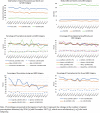Chronic High Risk Prescription Opioid Use Among Persons With HIV
- PMID: 34095287
- PMCID: PMC8176351
- DOI: 10.3389/fsoc.2021.645992
Chronic High Risk Prescription Opioid Use Among Persons With HIV
Abstract
Persons with HIV (PWH) are a population at risk for adverse sequelae of opioid use. Yet, few studies have examined correlates of chronic high risk opioid use and its impact on HIV outcomes. Trends in prescribing patterns and identification of factors that impact the use of opioid prescriptions among PWH are crucial to determine prevention and treatment interventions. This study examined electronic medical records (EMR) of patients receiving HIV care to characterize prescribing patterns and identify risk factors for chronic high risk prescription opioid use and the impact on HIV outcomes among PWH in primary care from July 1, 2016-December 31, 2017. EMR were analyzed from 8,882 patients who were predominantly male and ethnically and racially diverse with half being 50 years of age or older. The majority of the 8,744 prescriptions (98% oral and 2% transdermal preparations) given to 1,040 (12%) patients were oxycodone (71%), 8% were morphine, 7% tramadol, 4% hydrocodone, 4% codeine, 2% fentanyl, and 4% were other opioids. The number of monthly prescriptions decreased about 14% during the study period. Bivariate analyses indicated that most demographic and clinical variables were associated with receipt of any opioid prescription. After controlling for patient socio-demographic characteristics and clinical factors, the odds of receipt of any prescription were higher among patients with pain diagnoses and opioid use and mental health disorders. In addition, the odds of receipt of high average daily morphine equivalent dose (MED) prescriptions were higher for patients with pain diagnoses. Lastly, patients with substance use disorders (SUD) had an increased likelihood of detectable viral load compared to patients with no SUD, after adjusting for known covariates. Our findings show that despite opioid prescribing guidelines and monitoring systems, additional efforts are needed to prevent chronic high risk prescriptions in patients with comorbid conditions, including pain-related, mental health and substance use disorders. Evidence about the risk for chronic high risk use based on prescribing patterns could better inform pain management and opioid prescribing practices for patients receiving HIV care.
Keywords: HIV; chronic opioid therapy; morphine equivalent daily dose; opioid prescription; viral suppression.
Copyright © 2021 Ventuneac, Hecht, Forcht, Duah, Tarar, Langenbach, Gates, Cain, Rendina, Aberg and Perlman.
Conflict of interest statement
JA reports grants from Atea, grants from Emergent Biosolutions, grants from Frontier Technologies, grants from Gilead, grants and personal fees from Glaxo Smith Kline, grants from Janssen, grants and personal fees from Merck, grants from Pfizer, grants from Regeneron, grants from Viiv outside of the submitted work. The remaining authors declare that the research was conducted in the absence of any commercial or financial relationships that could be construed as a potential conflict of interest.
Figures

References
-
- Azar M. M., Springer S. A., Meyer J. P., Altice F. L. (2010). A Systematic Review of the Impact of Alcohol Use Disorders on HIV Treatment Outcomes, Adherence to Antiretroviral Therapy and Health Care Utilization. Drug And Alcohol Dependence 112 (3), 178–193. 10.1016/j.drugalcdep.2010.06.014 - DOI - PMC - PubMed
-
- Beltrami J. F., Fann S. A., Toomey K. E. (2000). Characteristics of Persons with AIDS in Rural and Urban Georgia: Use of Alcohol and Other Drugs, History of Sexually Transmitted Diseases and Tuberculosis, High-Risk Sexual Behaviors, and Problems Obtaining Social Services. J. Med. Assoc. Ga. 89, 10–14. - PubMed
Grants and funding
LinkOut - more resources
Full Text Sources

